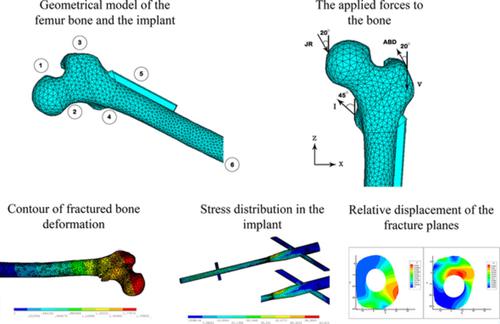当前位置:
X-MOL 学术
›
Int. J. Numer. Method. Biomed. Eng.
›
论文详情
Our official English website, www.x-mol.net, welcomes your feedback! (Note: you will need to create a separate account there.)
A comparative mechanical study of two types of femur bone implant using the finite element method
International Journal for Numerical Methods in Biomedical Engineering ( IF 2.1 ) Pub Date : 2021-03-26 , DOI: 10.1002/cnm.3459 Saeideh Hamidi 1 , Amir Khosravifard 1 , Mohammad Rahim Hematiyan 1 , Javad Dehghani 2
International Journal for Numerical Methods in Biomedical Engineering ( IF 2.1 ) Pub Date : 2021-03-26 , DOI: 10.1002/cnm.3459 Saeideh Hamidi 1 , Amir Khosravifard 1 , Mohammad Rahim Hematiyan 1 , Javad Dehghani 2
Affiliation

|
The femoral bone fracture is one of the most common fractures that orthopedic surgeons deal with. These fractures are associated with a significant percentage of death due to non-orthopedic complications. For this reason, it is necessary that the surgeon be well-aware of the condition of the patient and also of the biomechanical conditions of the bone and implant before surgery, in order to use the best surgical technique. Nowadays, the use of implants is a popular technique among the available methods for the treatment of femoral fractures. In the present study, two patients with different ages, three types of femoral bone fractures, that is, oblique, reverse oblique, and neck fracture, and two types of implants, namely, the dynamic hip screw (DHS) and the Gamma nail have been investigated. The behavior of the implants has been investigated at the two stages of treatment, that is, before and after bone union. The analysis of implants was based on the amount of stress and displacement induced in different parts of the bone and the implant. From the viewpoint of the stresses induced in the bone, all models are quite similar and in terms of the implant stresses, the Gamma nail is more reliable than the DHS. Additionally, the relative displacement of the fractured bone segments at the fracture planes was calculated. According to the obtained results, it can be concluded that the relative displacement of the fracture planes with the use of Gamma nail is somewhat less than the DHS, but this difference is not significant.
中文翻译:

两种股骨植入物的有限元力学比较研究
股骨骨折是骨科医生处理的最常见的骨折之一。由于非骨科并发症,这些骨折与很大比例的死亡有关。出于这个原因,外科医生必须在手术前充分了解患者的状况以及骨骼和植入物的生物力学状况,以便使用最佳的手术技术。如今,在治疗股骨骨折的可用方法中,植入物的使用是一种流行的技术。在本研究中,2例不同年龄的患者,股骨骨折3种类型,即斜、反斜和颈骨折,以及两种植入物,即动力髋螺钉(DHS)和伽玛钉。被调查。在两个治疗阶段,即骨愈合前后,对植入物的行为进行了研究。植入物的分析基于在骨骼和植入物的不同部位引起的应力和位移量。从在骨骼中引起的应力的角度来看,所有模型都非常相似,并且在植入应力方面,Gamma 钉比 DHS 更可靠。此外,还计算了骨折平面处骨折骨段的相对位移。根据所得结果可以得出结论,使用Gamma钉的骨折面相对位移略小于DHS,但这种差异并不显着。植入物的分析基于在骨骼和植入物的不同部位引起的应力和位移量。从在骨骼中引起的应力的角度来看,所有模型都非常相似,并且在植入应力方面,Gamma 钉比 DHS 更可靠。此外,还计算了骨折平面处骨折骨段的相对位移。根据所得结果可以得出结论,使用Gamma钉的骨折面相对位移略小于DHS,但这种差异并不显着。植入物的分析基于在骨骼和植入物的不同部位引起的应力和位移量。从在骨骼中引起的应力的角度来看,所有模型都非常相似,并且在植入应力方面,Gamma 钉比 DHS 更可靠。此外,还计算了骨折平面处骨折骨段的相对位移。根据所得结果可以得出结论,使用Gamma钉的骨折面相对位移略小于DHS,但这种差异并不显着。Gamma 钉比 DHS 更可靠。此外,还计算了骨折平面处骨折骨段的相对位移。根据所得结果可以得出结论,使用Gamma钉的骨折面相对位移略小于DHS,但这种差异并不显着。Gamma 钉比 DHS 更可靠。此外,还计算了骨折平面处骨折骨段的相对位移。根据所得结果可以得出结论,使用Gamma钉的骨折面相对位移略小于DHS,但这种差异并不显着。
更新日期:2021-03-26
中文翻译:

两种股骨植入物的有限元力学比较研究
股骨骨折是骨科医生处理的最常见的骨折之一。由于非骨科并发症,这些骨折与很大比例的死亡有关。出于这个原因,外科医生必须在手术前充分了解患者的状况以及骨骼和植入物的生物力学状况,以便使用最佳的手术技术。如今,在治疗股骨骨折的可用方法中,植入物的使用是一种流行的技术。在本研究中,2例不同年龄的患者,股骨骨折3种类型,即斜、反斜和颈骨折,以及两种植入物,即动力髋螺钉(DHS)和伽玛钉。被调查。在两个治疗阶段,即骨愈合前后,对植入物的行为进行了研究。植入物的分析基于在骨骼和植入物的不同部位引起的应力和位移量。从在骨骼中引起的应力的角度来看,所有模型都非常相似,并且在植入应力方面,Gamma 钉比 DHS 更可靠。此外,还计算了骨折平面处骨折骨段的相对位移。根据所得结果可以得出结论,使用Gamma钉的骨折面相对位移略小于DHS,但这种差异并不显着。植入物的分析基于在骨骼和植入物的不同部位引起的应力和位移量。从在骨骼中引起的应力的角度来看,所有模型都非常相似,并且在植入应力方面,Gamma 钉比 DHS 更可靠。此外,还计算了骨折平面处骨折骨段的相对位移。根据所得结果可以得出结论,使用Gamma钉的骨折面相对位移略小于DHS,但这种差异并不显着。植入物的分析基于在骨骼和植入物的不同部位引起的应力和位移量。从在骨骼中引起的应力的角度来看,所有模型都非常相似,并且在植入应力方面,Gamma 钉比 DHS 更可靠。此外,还计算了骨折平面处骨折骨段的相对位移。根据所得结果可以得出结论,使用Gamma钉的骨折面相对位移略小于DHS,但这种差异并不显着。Gamma 钉比 DHS 更可靠。此外,还计算了骨折平面处骨折骨段的相对位移。根据所得结果可以得出结论,使用Gamma钉的骨折面相对位移略小于DHS,但这种差异并不显着。Gamma 钉比 DHS 更可靠。此外,还计算了骨折平面处骨折骨段的相对位移。根据所得结果可以得出结论,使用Gamma钉的骨折面相对位移略小于DHS,但这种差异并不显着。


























 京公网安备 11010802027423号
京公网安备 11010802027423号